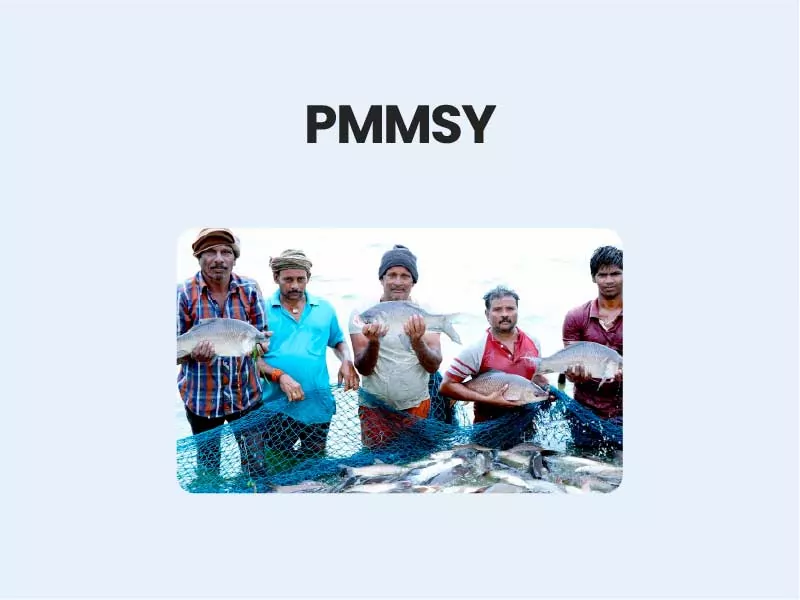
Pradhan Mantri Matsya Sampada Yojana(PMMSY)
The Finance Minister Nirmala Sitharaman reported Rs 20,000 Crore Scheme, under Pradhan Mantri Matsya Sampada Yojana. It is to address basic framework holes for the fisheries area. This uplifting news comes as a piece of the third tranche of financial changes.
It is a scheme to bring about Blue Revolution through sustainable and responsible development of the fisheries sector in India” with the highest ever investment of Rs. 20050 crores in fisheries sector comprising of Central share of Rs. 9407 crore, State share of Rs 4880 crore and Beneficiaries contribution of Rs. 5763 crore. PMMSY will be implemented over a period of 5 years from FY 2020-21 to FY 2024-25 in all States/Union Territories.
Aims and objectives of Pradhan Mantri Matsya Sampada Yojana PMMSY
- Harnessing of fisheries potential in a sustainable, responsible, inclusive and equitable manner
- Enhancing of fish production and productivity through expansion, intensification, diversification and productive utilization of land and water
- Modernizing and strengthening of value chain – post-harvest management and quality improvement
- Doubling fishers and fish farmers incomes and generation of employment
- Enhancing contribution to Agriculture GVA and exports
- Social, physical and economic security for fishers and fish farmers
- Robust fisheries management and regulatory framework
Current Scenario of the Fisheries Sector in India:
- The sector provides livelihood to more than 20 million fishers and fish farmers at the primary level and twice the number along the value chain. Fish being an affordable and rich source of animal protein is one of the healthiest options to mitigate hunger and malnutrition.
- The Gross Value Added (GVA) of fisheries sector in the national economy during 2018-19 stood at Rs 2,12,915 crores (current basic prices) which constituted 1.24% of the total National GVA and 7.28% share of Agricultural GVA
- Fisheries sector in India has shown impressive growth with an average annual growth rate of 10.88% during the year from 2014-15 to 2018-19.
- The export of marine products stood at 13.93 lakh metric tons and valued at Rs.46,589 crores (USD 6.73 billion) during 2018-19.
Implementation Strategy of PMMSY:
The PMMSY will be implemented as an umbrella scheme with two separate Components namely (a) Central Sector Scheme (CS) and (b) Centrally Sponsored Scheme (CSS). Under the Central Sector Scheme Component an amount of Rs. 1720 crores has been earmarked. Under the Centrally Sponsored Scheme (CSS) Component, an investment of Rs. 18330 crores has been envisaged, which in turn is segregated into Non-beneficiary oriented and Beneficiary orientated sub-components/activities under the following three broad heads:
- Enhancement of Production and Productivity
- Infrastructure and Post-harvest Management
- Fisheries Management and Regulatory Framework
Read Also Pradhan Mantri KISAN Samman Nidhi
Majority of the activities under the Scheme would be implemented with active participation of States/UTs. This inter-alia includes creation of State Programme Units in all States/UTs & District Programme Units and Sub-District Programme Unit in high fisheries potential districts.
Cluster or area-based approach’ would be followed with requisite forward and backward linkages and end to end solutions. Suitable linkages and convergence will be fostered with other centre and state government schemes wherever feasible.
Thrust will be given for infusing new and emerging technologies like Re-circulatory Aquaculture Systems, Biofloc, Aquaponics, Cage Cultivation to enhance production and productivity, quality, productive utilization of waste lands and water for Aquaculture. Special focus on Coldwater fisheries development and expansion of Aquaculture in Brackish Water and Saline Areas. PMMSY envisages promotion of high value species, establishing a national network of Brood Banks for all commercially important species, Genetic improvement and establishing Nucleus Breeding Center for self-reliance in Shrimp Brood stock, organic aquaculture promotion and certification, good aquaculture practices, end to end traceability from ‘catch to consumer’, use of Block Chain Technology, Global Standards and Certification, Accreditation of Brood banks, Hatcheries, Farms, residues issues and aquatic health management supported by a modern laboratory network
Focused attention would be given for fisheries development in Jammu and Kashmir, Ladakh, Islands, Northeast, and Aspirational Districts through area specific development plans.
Aquaparks as the hub of fisheries and aquaculture activities with assured, affordable, quality inputs under one roof, post-harvest infrastructure facilities, business enterprise zones, logistic support, business incubation centres, marketing facilities etc.
Private sector participation, development of entrepreneurship, business models, promotion of ease of doing business, innovations and innovative project activities including start-ups, incubators etc. in the fisheries sector.
Read Also Fasal Rahat Yojana
Enroll today with the best civils service academy and take your first step towards your Civils journey. Feel free to reach out to us for any inquiries, collaborations, or support. We’re here to help.

